The best wireless gaming earbuds in 2024
So you finally managed to bag a Steam Deck or ROG Ally, now what are the best gaming earbuds to go with it?
The best gaming earbuds have been a favourite for the active gamer. Whether jogging, commuting to work, or playing hours of Vampire Survivors on your Steam Deck, gaming earbuds give you the convenience and freedom you don't usually get from your typical bulky wireless gaming headset.
Obviously, for the best aural experience, nothing beats a traditional over-ear gaming headset, especially when you're in the comfort of your home or office. However, if you are out and about, it's nice to have a single pair of discreet earbuds that are small enough to fit into a pocket and can easily connect to your phone or laptop.
Unsurprisingly, there is a staggering number of earbuds to choose from. The right one for you should meet the following criteria; audio quality, sound isolation, battery life, and a decent gaming mode. Since we are dealing with Bluetooth connections, you'll want a pair with as little audio lag as possible when gaming.
But audio quality still has to be a key part of the debate. With many years of professional listening experience (I've also had ears all my life and can back that up with a lot of hearing at an amateur level), I've put all of these sets to the task of delivering in terms of both gaming and music listening.

As a keen handheld gaming PC user, Dave has been experimenting with all sorts of earbuds to get his portable gaming setup on flick, as the kids probably said once upon a time. Dave is also a keen enjoyer of music, high-end headphones, and audiophile gear, and has experience with all audio tech going back to the early days of TechRadar.
The Quick List
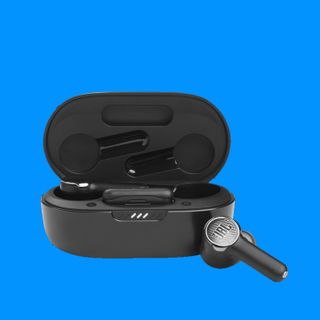
The best overall
These JBL buds are an extremely impressive all-rounder. The connection is solid and the audio is easy on the ears. The noise cancelling is surprisingly decent for buds, too, though it does come at the cost of battery life when enabled.
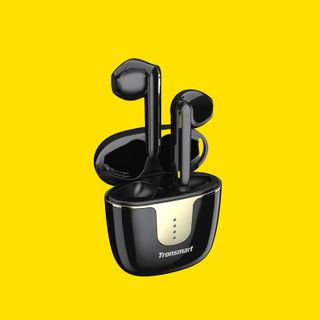
The best budget
In a world where everything seems to cost lots and lots of money, the Tronsmart thankfully don't. The battery life is also surprisingly strong for the cash.
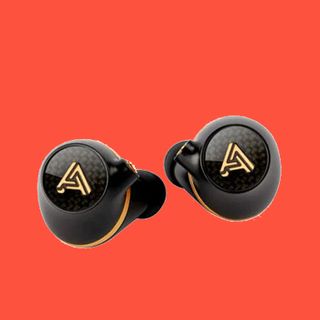
The best audiophile
Alright, these are ridiculous earbuds. They're extremely expensive but they're also doing something few, if any, can. They're planar magnetic buds. You heard me.
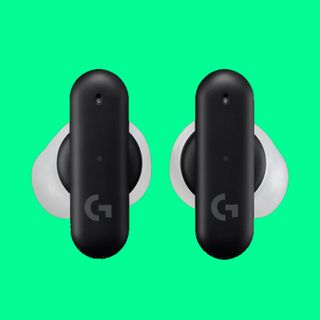
The best dual-mode
Both mobile and desktop buds rolled into one. These G FITS earbuds have an odd name but they look sleek and sound great, too.
Recent updates
This page was updated on September 26, 2024, to check over all of our options and make sure we are recommending the absolute best gaming earbuds. Phrasing and structure have also been adjusted for readability.
Best overall wireless gaming earbuds





Specifications
Reasons to buy
Reasons to avoid
The JBL Quantums are your classic wireless fare, aping the long-stemmed look of Apple's AirPods, but with a black finish. They come in a magnetic charging case, which helps extend the battery life of the buds themselves, and this case also holds the USB Type-C dongle, which allows you to connect to other devices, such as a gaming laptop.
That's one of the features which propels the JBL Quantums ahead of the pack; the fact that it has both Bluetooth 5.2 connectivity and 2.4GHz wireless via a Type-C dongle. The switching is fast, and the connection is robust.
The noise cancelling is decent, too, even if it inevitably cuts down the battery life from eight to five hours. Using the JBL phone app you can tune them to your ear canal to further enhance the ANC as well. I would say the Creative Outlier Pro buds have the edge when it comes to completely block the outside world, but the Quantum buds are still impressively effective.
The fact you can jam the Type-C dongle into your laptop or Steam Deck and play without delay makes the Quantums incredibly versatile.
But what about the audio quality? I've said they're not the best-sounding buds I've tested, but the sound quality is still really good. I would steer clear of the QuantumSURROUND feature if you're running them from the USB dongle on your desktop PC, though—I almost blew out my eardrums with the unreasonable bass thuds in Red Dead Redemption 2 from just a short gallop through the desert cacti.
With that off, the bass tones are more subtle. I did bump the EQ to Bass over the Bluetooth connection to squeeze a little more feeling out of The War on Drugs, but in general, they sound better with a flat EQ. The JBL app will also allow you to enable game mode, which helps sync game and video audio, but the fact you can jam the Type-C dongle into your laptop or Steam Deck and play without delay makes the Quantums incredibly versatile.
And they're affordable, too. Considering that the Audeze Euclids—easily the best-sounding earbuds I've ever used—is $1,200, the JBLs are more usable daily, and a tenth of the price is pretty astounding.
Read our full JBL Quantum TWS review.
Best budget wireless gaming earbuds





Specifications
Reasons to buy
Reasons to avoid
I wasn't expecting a lot from the most budget wireless gaming earbuds I've tested recently, but honestly, they're not bad. At full price, I would absolutely recommend spending that little bit extra on the Creative Outlier Pro, but if you're willing to ship from Tronsmart via its AliExpress storefront you're looking at almost half the $60 sticker price.
And at that level, these are some great budget wireless buds. They have a decent battery life, solid Bluetooth 5.2 connection, and come with a dedicated gaming mode accessible directly through the headphones rather than enabled via a separate app.
And that gaming mode is actually pretty impressive, too. It perfectly matches the gunshots in Hitman 3 via Bluetooth on the Steam Deck or a gaming laptop, and makes for a great, super portable gaming experience. Tronsmart recommends disabling gaming mode for music as it won't offer the best audio experience, but I noticed nowhere near the same strange aural artifacts as with the Gravastar Sirius Pro buds.
Leaky as a colander that's been sieving shotgun pellets direct from the muzzle.
Generally speaking, the audio is good. Not great, but it's only really a lack of direct oomph in the low ends that marks the sound out. I don't love an overly bass-heavy tuning anyway, but the Onyx Ace Pro buds do still feel lightweight on that front. The highs and mids are crisp, however, and the audio is nicely detailed despite that slight bass tone failing.
These things are leaky as a colander that's been sieving shotgun pellets direct from the muzzle, however. You can hear everything. If you're concerned about being oblivious to traffic when you're crossing the road, fine, but if you want to use the Onyx Ace Pro buds to game on the go you're going to suffer.
That's a problem because most of the situations where I want to be using a set of wireless earbuds for gaming will find me on some sort of transport or in a public place. And generally not sat in a quiet room with a level of noise that isn't going to aurally intrude upon my play time.
If you're after a good budget set of AirPod-a-likes for your Steam Deck, however, the Tronsmart Onyx Ace Pro will make for a solid purchase. So long as you pick it up with that AliExpress discount, that is.
Read our full Tronsmart Onyx Ace Pro review.
Best audiophile wireless gaming earbuds





Specifications
Reasons to buy
Reasons to avoid
If it was all about the sound, I would be tripping over myself to recommend you stick Audeze's Euclid earbuds into your soundholes. The sound is delicious. Because when you're trying to describe audio quality, it's important to keep using different adjectives, and whenever I stick some high-res audio files through the Euclid buds, I always end up going 'Nom, nom, nom, nom.'
But how do you, in all good faith, recommend someone spend $1,300 on a set of earbuds? I'll wait for you to crank your jaw up off the deck… yes, the Audeze Euclid buds really do cost that much. And if you want to go down the wireless Bluetooth 5.0 route, then you need a $130 adapter wrapped around your neck.
Which makes them suitable only for the most minuscule of audiophile niches, if I'm being honest. Generally, if you want that high-end audio experience, you spend big on a pair of over-ear audiophile headphones.
The Euclids, even ignoring the pricey elephant in the room, have too many real-world sticking points.
Despite initial concerns, the Bluetooth 5.0 implementation wouldn't have the speed of connection to live with the lag-free wireless audio you really need for twitch gaming; the Euclid Bluetooth adapter is lightning fast.
Which all makes them actually an excellent set of earbuds for gaming. But you don't need a set of buds at this price level to get a very close approximation of this audio quality from a particular game. The Creative Outlier Pro buds deliver an impressive aural experience for a fraction of the price, and the JBL Quantum TWS has the ease of use to make them both an easy Steam Deck accessory you barely have to think about.
The Euclid on the other hand, even ignoring the pricey elephant in the room, have too many real-world sticking points to make them a reasonable recommendation.
The eight-hour battery life of the Bluetooth adapter is an issue, though you could, of course, quickly switch to a wired connection when you run out of power. But, even if the power thing isn't an issue, you're still having to deal with the adapter cabling between the two buds, which I found either weighed down too much if worn around the front of your neck, or tangled with any collars on my clothing, putting pressure on the buds' fitting if worn around the back.
And I struggled with that fitting in general anyways. None of the other wireless buds I've tested was much of a struggle to comfortably sit in my, admittedly small, ears, but I found with the Euclids—even with three different silicone tips, and a pair of premium Comply foam tips—long-term comfort was difficult to find.
Read our full Audeze Euclid review.
Best dual-mode wireless gaming earbuds





Specifications
Reasons to buy
Reasons to avoid
There's a lot to be said about real-world functionality. When a product just fits into your life so easily as to push out one which might be empirically 'better' you know it's got something tangible to offer. That's where I am with the Logitech G FITS earbuds. They're now the buds I use on a day-to-day basis, and have replaced the gaming headset I use in the office, too.
That's because of their dual-mode wireless design and how easy it is to switch back and forth. I can wear the FITS on my walk into the office listening to stuff on my phone, switch on my PC, and then one quick triple-tap and I'm hooked into my desktop rig. Then, when I shut down at the end of the day, I can just walk away and it'll automatically reconnect to my phone for the bus ride home. Yeah, I'm a one-way walker. It's a big hill to get back home.
The Logitech buds are comfortable enough that wearing them for such an extended period of time isn't really an issue. That's largely because they actually mould to your ears when you first use them. It's a slightly odd feature, and a slightly odd sensation when they're forming to your ear-holes, too, because they do get warm.
You don't have to jam the buds into your ears in order for them to stay put.
Logitech calls it Lightform and it uses UV LEDs in the buds to harden a material in the earbud tips (a photopolymer) that is designed to form to your ears' individual shape. This has the combined effect of giving you a secure fit so they don't fall out, and delivers a natural sound isolation that means Logitech doesn't need to add any battery-draining ANC features to its buds.
It's not as effective as dedicated active noise cancelling and does mean in very loud environments you will get some of the outside world leaking in, but it's still pretty effective.
This fitting process also means you don't have to jam the buds into your ears in order for them to stay put, either. That's something that can become uncomfortable after a while, no matter what kinds of alternative tips other earbuds ship with.
And what of the sound? Therein lies some of the compromise. Despite the high price, you are still getting a relatively standard 10mm driver, and while they deliver a good audio experience, I'd maybe say they're a little top heavy. That's not to say you're losing out at the lower end of the scale because there's a decent level of tonal clarity across the range, but out of the box they tend towards the high tones.
That's me picking some nits, switching from some high-end, over-ear headphones to these for some comparison. But in general use, I've been really pleased with the sound quality, whether I'm listening to audiobooks, music, or gaming in the office when I should be working. I'm testing product. That's what I tell people.
The Logitech G FITS do have the same issue that crops up with so many different wireless earbuds, however, namely occasional connection hiccups. It's admittedly pretty infrequent, but sometimes you'll find one bud or the other not turning on when you pull them from their carry case. It just needs quickly dropping back into the case and pulling out again, so it's only a minor annoyance. And it's something I've experienced with pretty much every set of wireless earbuds I've ever tested, too.
Logitech has priced its G FITS buds rather high, however. And, while they do have a bit of a premium flair to them, the audio isn't quite good enough to completely sway me that they're worth their $200+ price tag. Yet if you consider they can replace the gaming headset you have plumbed into your desktop at home as well as being your out-and-about earbuds, so maybe there's some value play in that dual-mode usage model.
Read our full Logitech G FITS review.
Also tested
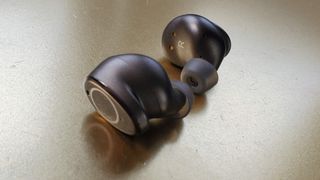
Technically excellent, the Outlier Pro buds sound great and deliver a feature set to rival any of the higher priced wireless earbuds, but those ergonomic frustrations have me regularly reaching for an alternative.
For
- Great ANC
- Good price
- Excellent battery life
- Impressive audio
- Speedy connection
Against
- Awkward touch controls
- Frustrating day-to-day experience
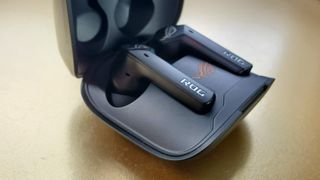
An absolutely fine set of wireless earbuds. The connection is speedy, robust, and comes with decent battery life. Though also comes with rather weak audio quality that makes the whole package end up feeling a bit limp despite the quality feature set.
For
- Good all-round feature set
- Simple controls
- Easy game mode
Against
- Limp audio quality
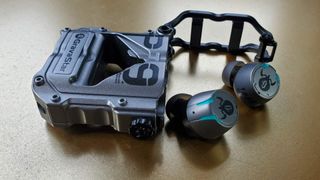
Maybe the excessive bass response works for your musical tastes, but the weak battery life, and sacrificing audio in favour of low latency gaming, makes me want to swerve the Gravastar buds.
For
- Strong gamer aesthetic
- Doubles as a bottle opener
Against
- Bass-heavy audio
- Weak battery life
- Low latency mode sacrifices sound quality
Wireless gaming headset FAQ
How do you test wireless gaming earbuds?
More than a standard wireless gaming headset, you have to test earbuds for a longer time. Comfort and general ergonomics are key to a set of buds that you're likely to use every time you leave the house, whether tethered to your phone for music or podcasts or connected to your gaming laptop or Steam Deck for mobile fun times.
We will use a set of buds for an extended period of time, testing with mobile gaming in mind, plugged into the Steam Deck, and using high-resolution audio to get a bead on the overall sound quality.
Latency is also of vital importance when we're talking about wireless earbuds, so being able to turn on game mode, and it being seamless when gaming, is a necessary part of testing, too.
Can wireless earbuds be used for gaming?
There are certain things to look for when chasing a wireless set of earbuds for gaming. They need to at least have Bluetooth 5.0 to deliver a low latency connection, but it's also worth looking for a dedicated gaming mode, which drives latency down even lower.
This ideally should be enabled via the buds themselves, and not from an app, to make them easily compatible with a gaming laptop or handheld gaming PC such as the Steam Deck.
There are buds with 2.4GHz wireless dongles, which will cut latency down to an almost invisible level, which is also worth considering.
Are wireless gaming earbuds more expensive?
The sad fact is that you are likely to be paying a premium for a wireless version of any product. You have to factor in the extra design, the extra connectivity peripherals (the wireless dongle, etc.), and the fact you now have to have a battery.
The biggest gaming news, reviews and hardware deals
Keep up to date with the most important stories and the best deals, as picked by the PC Gamer team.

Dave has been gaming since the days of Zaxxon and Lady Bug on the Colecovision, and code books for the Commodore Vic 20 (Death Race 2000!). He built his first gaming PC at the tender age of 16, and finally finished bug-fixing the Cyrix-based system around a year later. When he dropped it out of the window. He first started writing for Official PlayStation Magazine and Xbox World many decades ago, then moved onto PC Format full-time, then PC Gamer, TechRadar, and T3 among others. Now he's back, writing about the nightmarish graphics card market, CPUs with more cores than sense, gaming laptops hotter than the sun, and SSDs more capacious than a Cybertruck.
Most Popular


